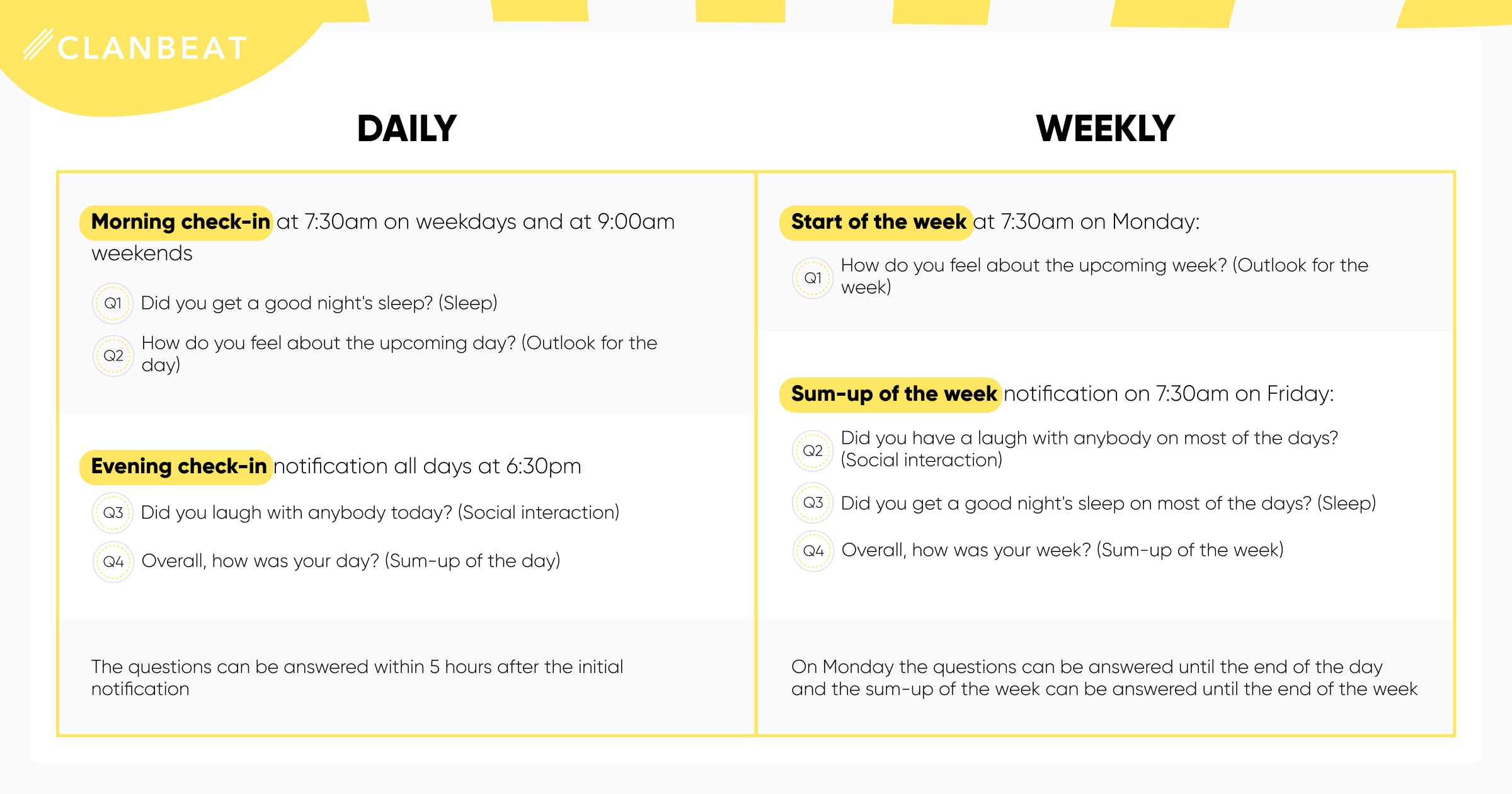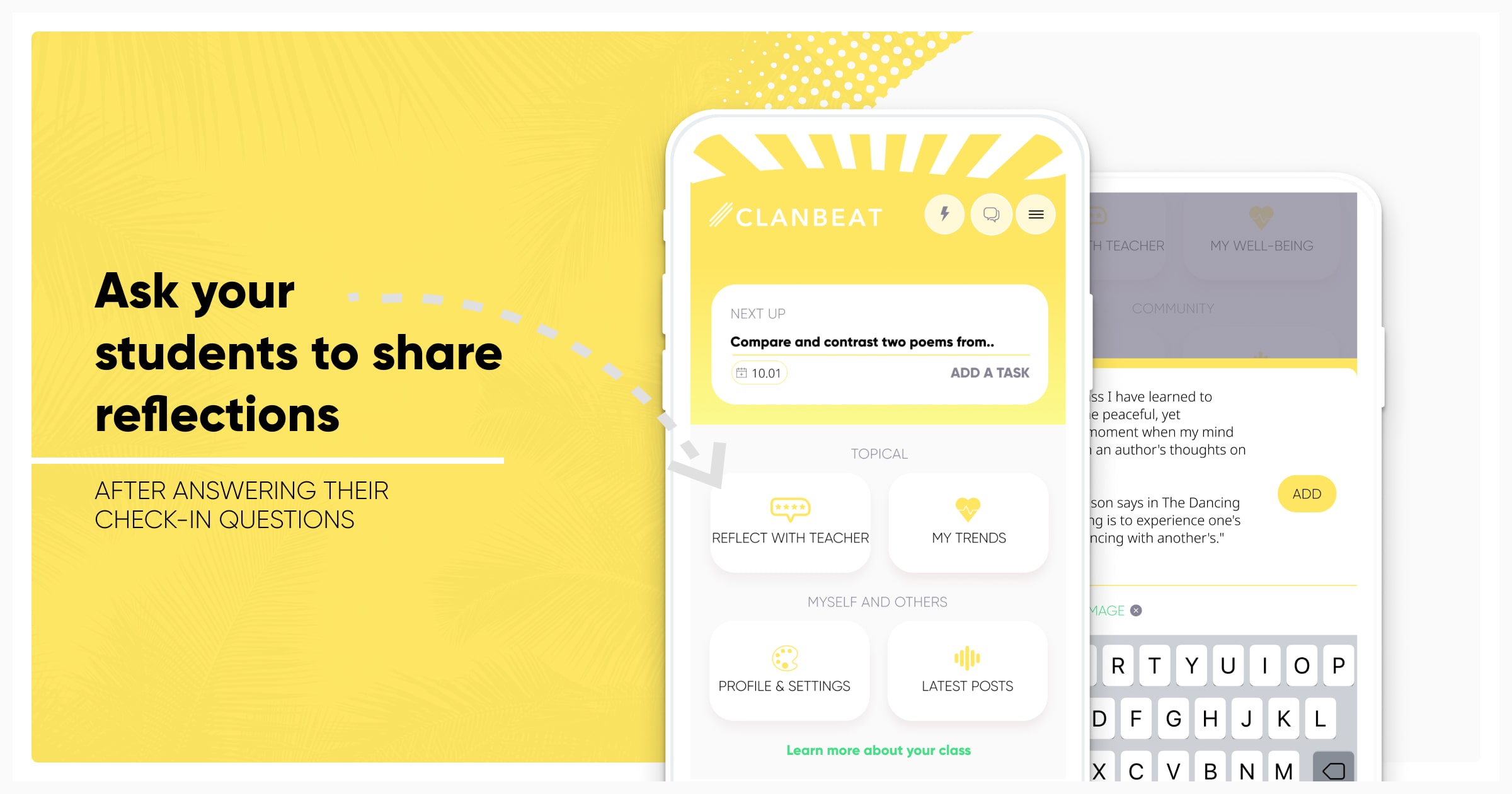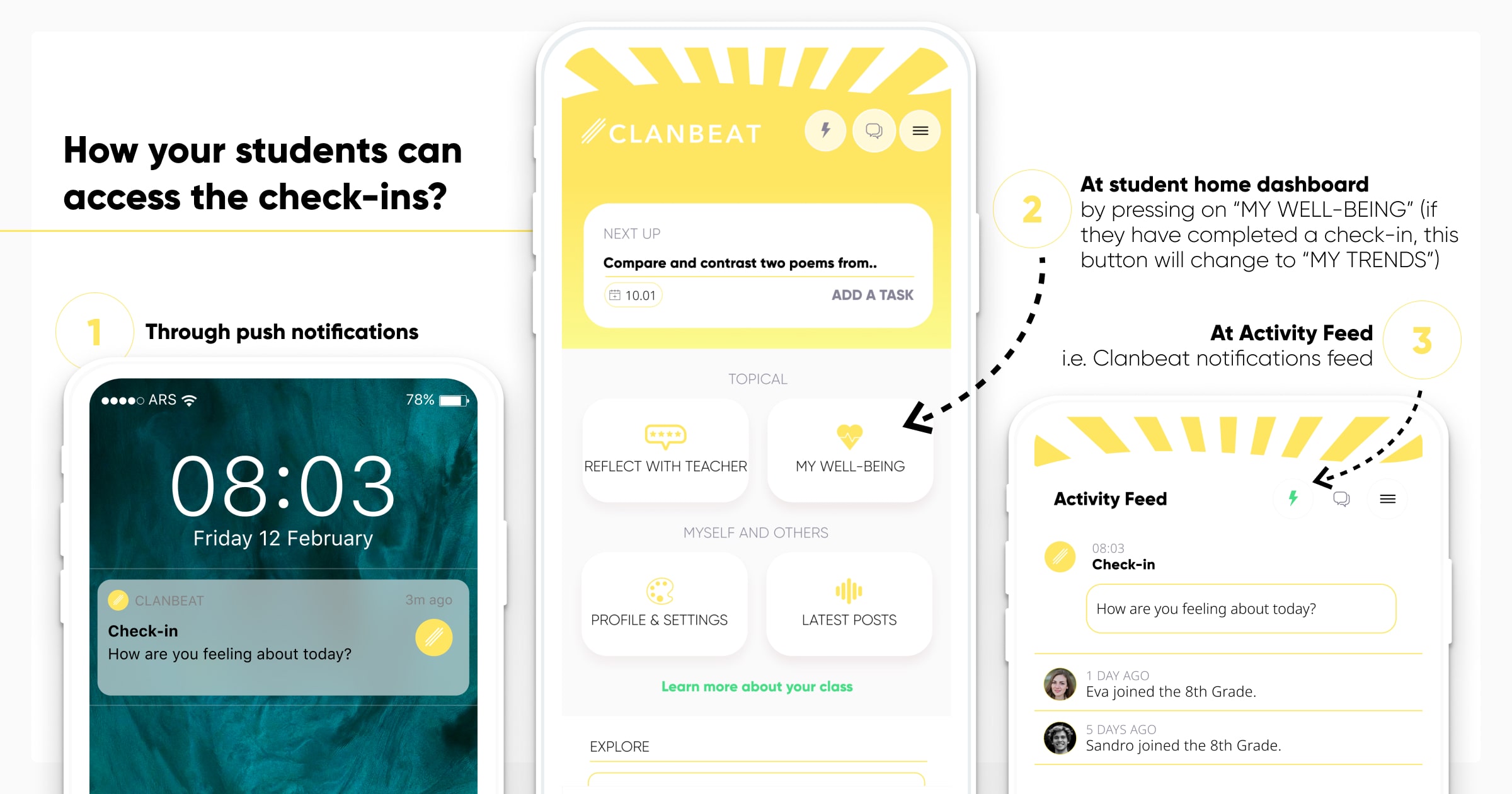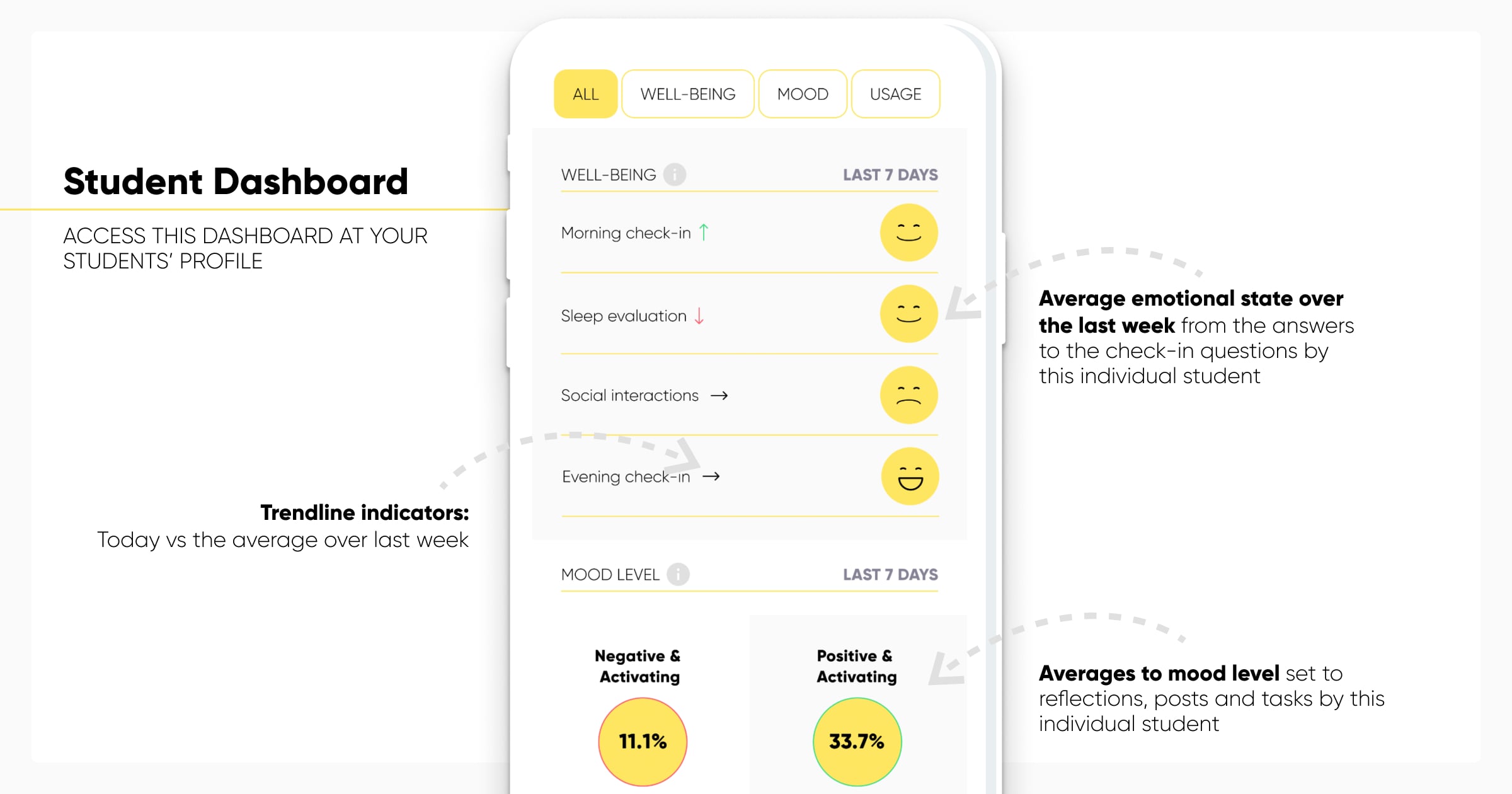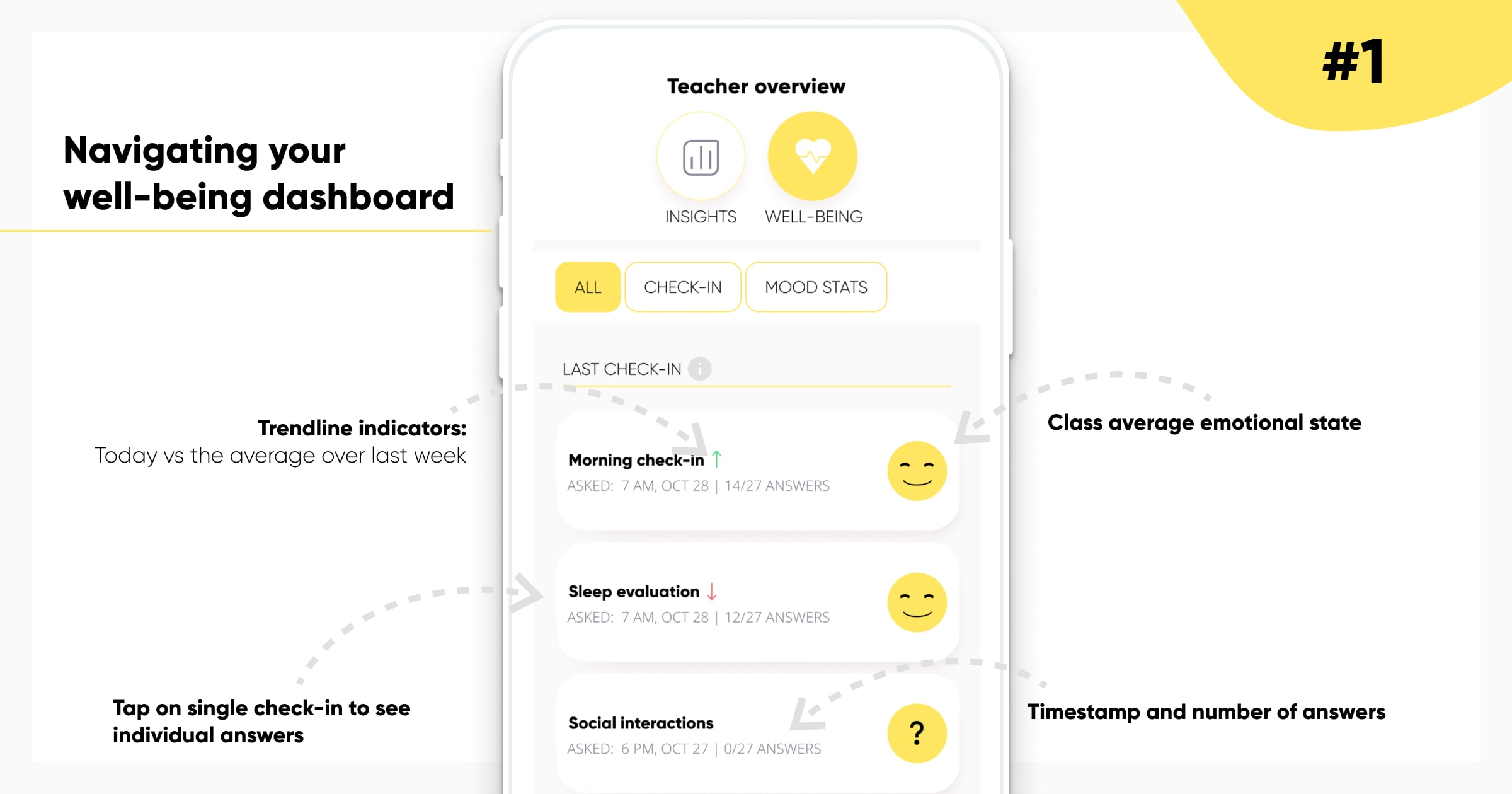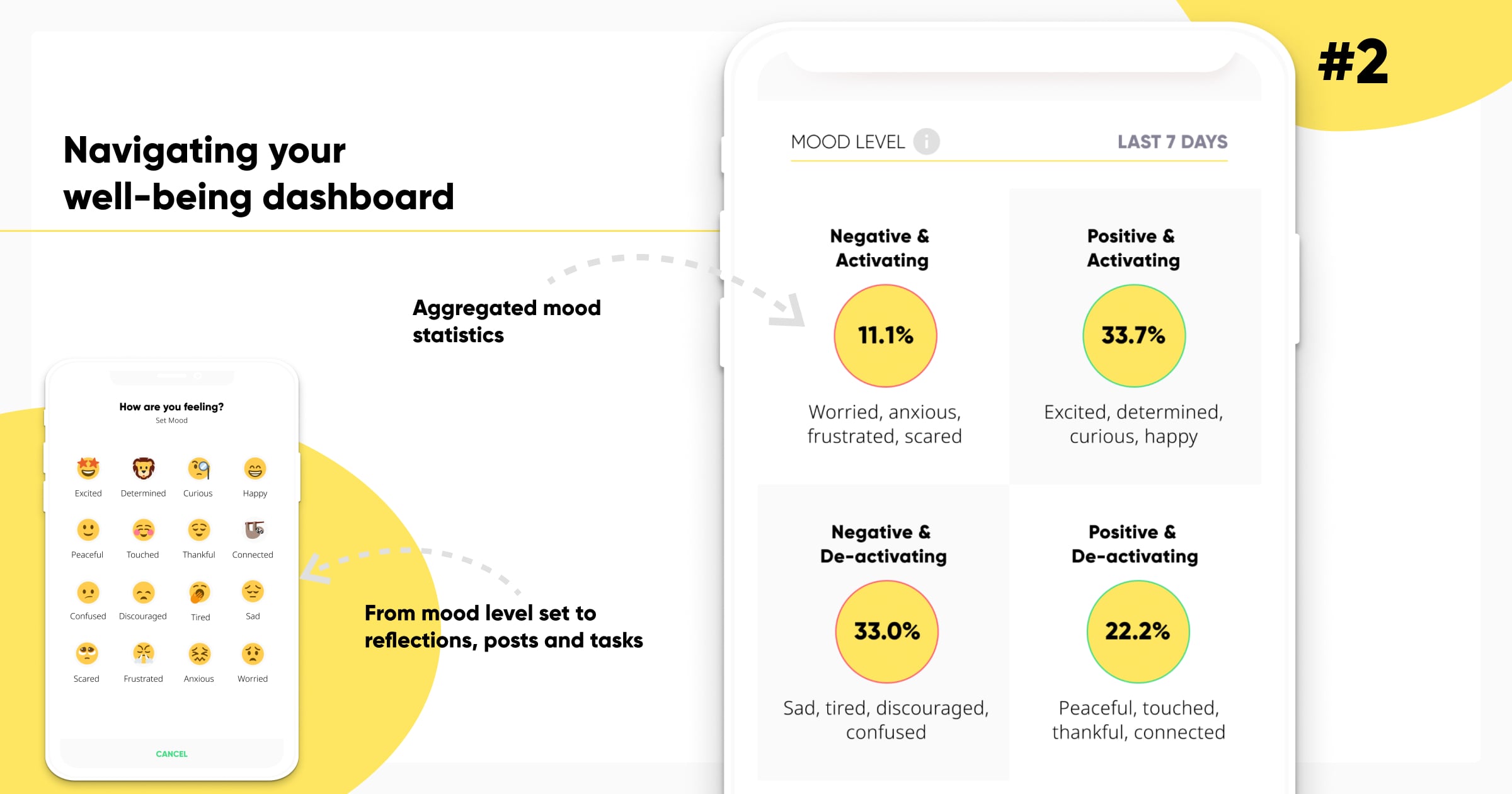Well-being check-ins
Clanbeat app feature deep dive | FAQ

Table of contents
What is the aim of asking well-being questions?
We want each and every student to feel that they are valued. Their views, emotions and experiences matter and we want to support them during times of difficulty.
These questions are the opportunity for meaningful non judgemental conversations to take place.
Often we can feel defensive if we are asked if there is something wrong, we may feel like we are being judged and our automatic response to that is usually to defend. We want to create the opportunities for teachers and school leaders to have safe conversations with their students.
How do they work?
Firstly you decide the frequency of the check-ins. We recommend daily for at least 2 weeks for you to get a picture of each students’ well-being. You do this at your group preferences – default is daily.
All the students on your Clanbeat account will then receive the questions automatically in the form of notifications on phone asking them to give a rating from very sad to very happy.
The use of emojis also provides students who struggle with writing, or whose first language isn’t English with the opportunity to voice how they feel through a user-friendly scale
To encourage student agency and a growth mindset you should ask your students to also complete a reflection in the app when they have answered their questions (both morning and afternoon).
What happens for students when the questions are answered?
The student receives an automated notification when they complete the questions. In case negative patterns are detected, the notification will be based on their responses and may advise that they seek help if they have responded that they are having difficulty. Also, an acknowledgment message is provided when a student regularly answers the check-in questions which encourages them to continue to use the check-ins
The data is displayed in real time on both the teachers and students dashboard.
What is the student’s dashboard?
The student dashboard gives an overview of the well-being check-ins for students themselves. If answered regularly the dashboard shows how it has been for the student lately (showing the average of the last 7 days) and compares it with the state for the current day to notice the changes and to normalise the way we might feel on different days. It helps to build self-awareness and fuel the habit of checking in as the results are seen and owned by students themselves.
Besides well-being check-in data, the student dashboard gathers also the mood info tracked through different features used by students where the emotional state can be added (reflections, chats, posts, tasks). This overview helps to get a better understanding about the emotional palette that prevails based on the app usage and also gain insight about different energy levels tied to them.
What is the teachers dashboard?
The information on the teachers dashboard allows them to make informed decisions for next steps for the well-being of their students and of the class as a whole.
Through the dashboard teacher gets access to the overall sentiment in the class for the current day that is compared to the recent level (check-ins for last 7 days). Teachers can look into the daily reported data and get an overview how every student has answered and how the current day looks for the student when compared to his/her recent state (last 7 days). The same info is accessible for the teacher if she/he visits the student’s personal profile. Also, the info who has not answered is shown on the dashboard to be mindful whether there is a further reason to get in contact with the student.
Additionally, there is the overview about the students’ mood level for the past 7 days gathered all over the features where mood tracking is an option for students (reflections, chats, posts, tasks).
What are Flags? And who sees them?
Flags for teachers (tracks changes, negative responses, no answers)
Based on the answers that students report through well-being check-ins, the system monitors negative responses, big changes, both positive and negative, and cases where students have not checked in.
The flags will be shown only to teachers and they are shown on real-time basis ie if a certain criteria is met. For example if the student reports at least 3 days a week that they are having difficulties with sleeping or if the outlook for the day during past week has dropped significantly compared to the average level the student witnessed before.
These flags are meant to capture the opportunity of early intervention and draw teacher’s attention efficiently to aspects that might get lost on a daily basis. There are altogether 14 flags for daily check-ins and 14 for weekly check-ins. They appear when the defined circumstances are in place and disappear when the input has changed.
Additionally to well-being check-ins there are also some other flags that capture reported moods (anxiety, tiredness) and students’ app usage.
Why are check-ins necessary?
Schools provide an ideal environment for promoting good emotional well-being and identifying early behaviour changes and signs of mental distress. For children experiencing adversity at home, school can also provide a consistent, protective and therapeutic environment, which can help them to cope.
Furthermore, students need education to include how to understand and look after their mental health – just like we learn how to look after our physical health. By shifting the focus to preventing mental health problems and building resilience we can do so much to improve the lives of so many. Good well-being on leaving school has a much greater impact on life outcomes than exam success.
The check-ins are a means which measure the students well-being and help to provide targeted support to the students that need it. Check-ins place greater focus on prevention through early identification and prompting intervention.
What is the value of using well-being check-ins for teachers?
Teachers have had an increase in work loads, student numbers, areas of responsibility, and with the rise in the number of students with mental health problems, as a teacher your time is at a premium.
Due to the nature of your role, and your continued connection with your students you are uniquely placed to model good practice and to be a first responder to a young person’s and by identifying, intervening and supporting their mental health issues.
- Reaching the entire class, all at the same time
- Getting honest answers
- Removing the pressure of group acceptance
- Students can answer no matter where they are
- A way to connect to the students that display little or no visible signs of distress
- You get personalised data for each student
- Support materials which will provide advice on how to talk to the student about their issue
- Be alerted to social and emotional issues before they become a problem
- Targeted intervention - you spend time on the students that need it
- Feedback on what questions the students struggled with
- A way to keep communications open and offer support even remotely
What is the value of using well-being check-ins for students?
As with all of our Clanbeat features, we wish to develop student well-being and agency. Clanbeat check ins:
- Give each student the opportunity to be aware of their emotional response
- Allow students to express their feelings without having to verbalise them
- Reaffirm that the school is there to support their emotional well-being
- The questions stimulate students to reflect on their experience, emotions and thoughts
- Provide automated responses that support student well-being, giving students the opportunity to make changes for themselves
Something to highlight as an extra, it also provides students with a mechanism in which they can seek help without having to verbally ask for it. This is especially useful for:
* Shy students
* Students who’s first language is not English
* Students that are having difficulties and cannot find the words to express them
* Students that are too scared to speak up but need help
What is the value of using well-being check-ins for schools?
Over the course of their education, children spend over 7,800 hours at school. With such a huge amount of time, schools provide an ideal environment for promoting good emotional well-being and identifying early behaviour changes and signs of mental distress. Check-ins sit alongside existing well-being programmes, providing schools with a powerful tool to help identify changes in behaviours and signs of mental distress.
- Allows teachers, school counsellors and leaders to gain an insight to ALL students Social and Emotional Wellbeing
- A FREE early intervention strategy, identification potential issues before they become a problem. Alerts are sent directly to the teacher, allowing for supportive conversations to take place between them and the students.
- Schools can use the data alongside in house interventions to refer students to support care pathways and protocols
- Data for each student can be analysed to allow monitoring of wellbeing and growth
What does it mean for well-being in the school?
Well-being is a very broad concept and in our case can be defined as students’ overall development and satisfaction with life.
On a more detailed level well-being is tied to psychical and mental health, tied to feelings how happy or satisfied one is with different aspects of his/her life, how connected they feel with others and what is the outlook for the future. Well-being is also tied to skills and attitudes that promote well-being itself.
Different schools have different models of well-being tied into their curriculum and school culture. We have mapped the check-ins to some of the widely used models including PERMAH, SEL, SHANARRI. If your model is not listed please contact us at [email protected] and we will map your well-being model.
Check-ins and COVID
Do you need a way to gauge the well-being of your students during the COVID pandemic?
When students are in school, it is easier for teachers to spot signs of distress, anxiety or emotional difficulty. However while students are behind a mask or a screen the visual and behavioural cues are not as easy to spot.
The well-being check-ins provide an opportunity for teachers to continue to monitor students emotional and physical wellbeing no matter where they are.
What is the mental health impact of COVID
An ongoing study by the Institute for Fiscal Studies shows that young people’s mental health has worsened substantially during the pandemic. The Opinions and Lifestyle Survey (OPN) that has been monitoring the social impact of COVID-19 has found that young people are more likely than other age groups to report that lockdown has made their mental health worse.
Young people’s well-being was already a concern before COVID-19, with a rise in the proportion of young people reporting symptoms of anxiety and depression increasing from 18% in 2009/10 to 21% in 2013/14.
Furthermore, evidence that the coronavirus pandemic is having a negative impact on the mental health of children and young people continues to build. The ongoing research by the Evidence Based Practice Unit (emerging evidence report 5) shows that
- Large studies found increases in the prevalence of anxiety and depression among young people during the pandemic.1–3
- Findings regarding the relationship between the pandemic and suicide are mixed. Over a quarter of 18-24 year olds had seriously contemplated suicide between May-June 2020, which is a higher proportion than older age groups (U.S.). Non-Hispanic Black and Hispanic young people seemed to be particularly impacted.4 However, another study did not find an association between suicide rates and school closures (Japan).5
- Studies have discussed the harmful effect of the pandemic on psychological wellbeing 6–9 and related factors such as worry, happiness, stress, and life satisfaction.
References
1. Pierce, M. et al. Mental health before and during the COVID-19 pandemic: a longitudinal probability sample survey of the UK population. The Lancet Psychiatry 7, 883–892 (2020). doi: 10.1016/S2215-0366(20)30308-4 2. Wang, Z. H. et al. Prevalence of anxiety and depression symptom, and the demands for psychological knowledge and interventions in college students during COVID-19 epidemic: A large cross-sectional study. Journal of affective disorders 275, 188-193 (2020). doi:10.1016/j. jad.2020.06.034 3. Meng Qi, M. S. et al. The Effect of Social Support on Mental Health in Chinese Adolescents During the Outbreak of COVID-19. Journal of Adolescent Health 67, 514-518 (2020). doi: 10.1016/j.jadohealth.2020.07.001 4. Czeisler, M. É. et al. Mental Health , Substance Use , and Suicidal Ideation During the COVID-19 Pandemic. MMWR 69, 2018–2019 (2020). 5. Isumi, A. et al. Do suicide rates in children and adolescents change during school closure in Japan? The acute effect of the first wave of COVID-19 pandemic on child and adolescent mental health. Child abuse & neglect, 104680 (2020). doi: 10.1016/j.chiabu.2020.104680 6. Scottish Government. Children, Young People and Families COVID-19 Evidence and Intelligence Report. (2020). 7. Mondragon, N. I. et al. Struggling to breathe: a qualitative study of children’s wellbeing during lockdown in Spain. Psychology & Health (2020). doi:10.1080/08870446.2020. 1804570 8. Office of National Statistics. Coronavirus and the social impacts on young people in Great Britain 3 April to 10 May 2020 (2020). 9. Gassman-Pines, A., Ananat, E. O. & Fitz-Henley, J. COVID-19 and Parent-Child Psychological Well-being. Pediatrics 146 (4) e2020007294 (2020). doi:
